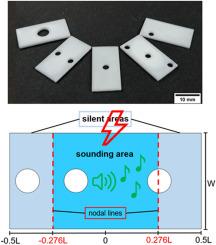The sound of porosity: Suitability of the impulse excitation technique (IET) to determine the Young's modulus of 2D macroporous ceramics
IF 2.9
Q1 MATERIALS SCIENCE, CERAMICS
引用次数: 0
Abstract
The presence of pores in a ceramic leads to a lower Young's modulus compared to dense material. For the development of porous ceramics with tailored elastic properties, an exact determination of the Young's modulus is required, especially for industrial applications. Therefore, we investigated the suitability of the non-destructive impulse excitation technique for measuring the dynamic Young's modulus of two-dimensional ceramics with low porosity (P < 19 %). For rectangular samples it was shown that the measurement results depend on the geometric pore position, as added pores outside the nodal lines of the fundamental flexural vibration had no influence on the result. Pores in the inner part of the sample led to a decrease of the Young's modulus that is in good agreement with empirical and analytical models. For the investigated interval of porosity range, the influence of pore size and geometric position on the reduction of the Young's modulus was determined.

多孔性的声音:脉冲激励技术(IET)测定二维大孔陶瓷杨氏模量的适用性
与致密材料相比,陶瓷中孔隙的存在会导致较低的杨氏模量。为了开发具有定制弹性特性的多孔陶瓷,需要精确测定杨氏模量,尤其是在工业应用中。因此,我们研究了非破坏性脉冲激励技术是否适用于测量低孔隙率(P < 19 %)二维陶瓷的动态杨氏模量。对于矩形样品,测量结果取决于孔隙的几何位置,因为在基本挠曲振动节点线外增加的孔隙对测量结果没有影响。样品内部的孔隙会导致杨氏模量下降,这与经验模型和分析模型十分吻合。在所研究的孔隙率范围内,确定了孔隙大小和几何位置对杨氏模量降低的影响。
本文章由计算机程序翻译,如有差异,请以英文原文为准。
求助全文
约1分钟内获得全文
求助全文
来源期刊

Open Ceramics
Materials Science-Materials Chemistry
CiteScore
4.20
自引率
0.00%
发文量
102
审稿时长
67 days
 求助内容:
求助内容: 应助结果提醒方式:
应助结果提醒方式:


